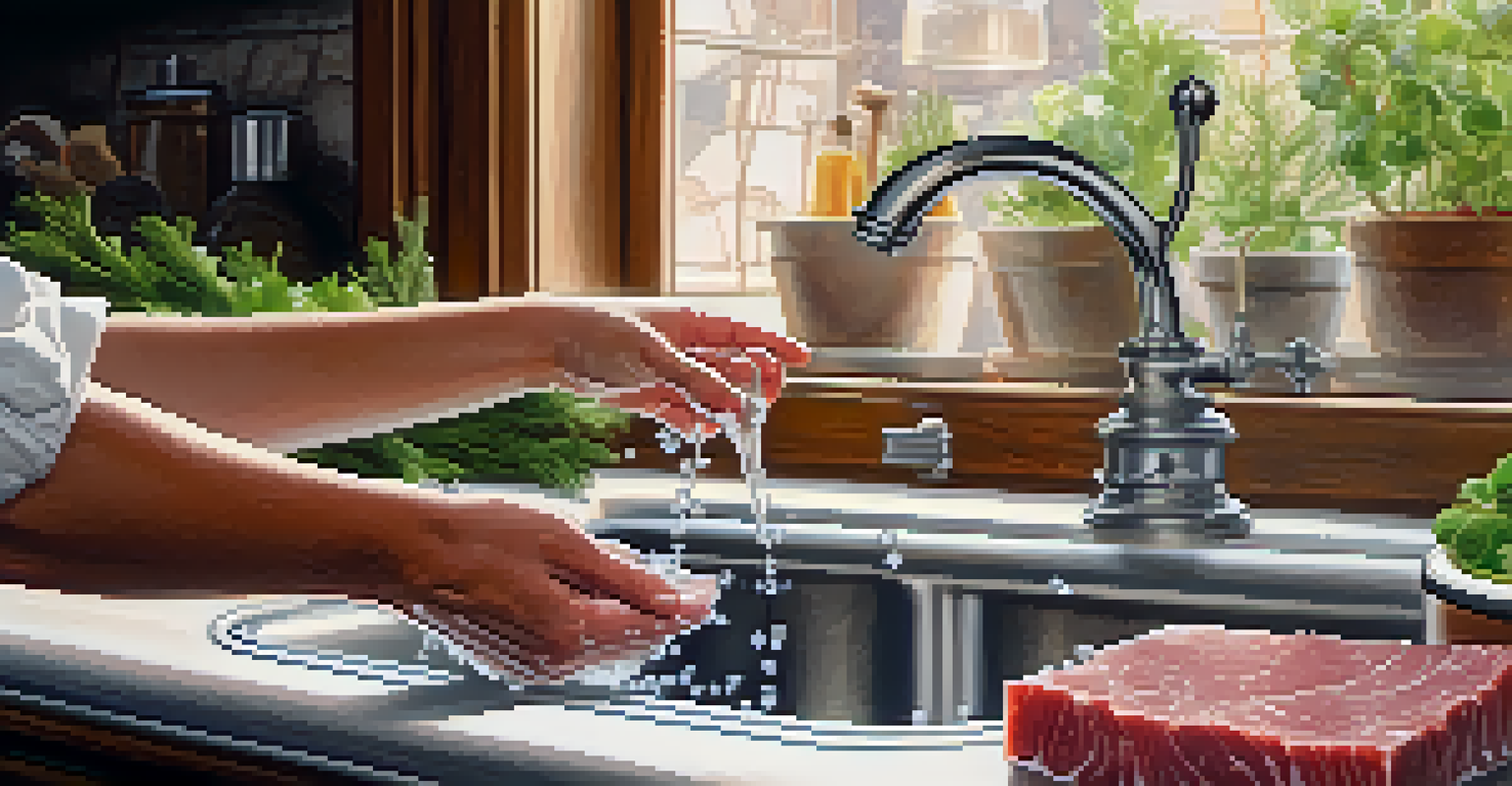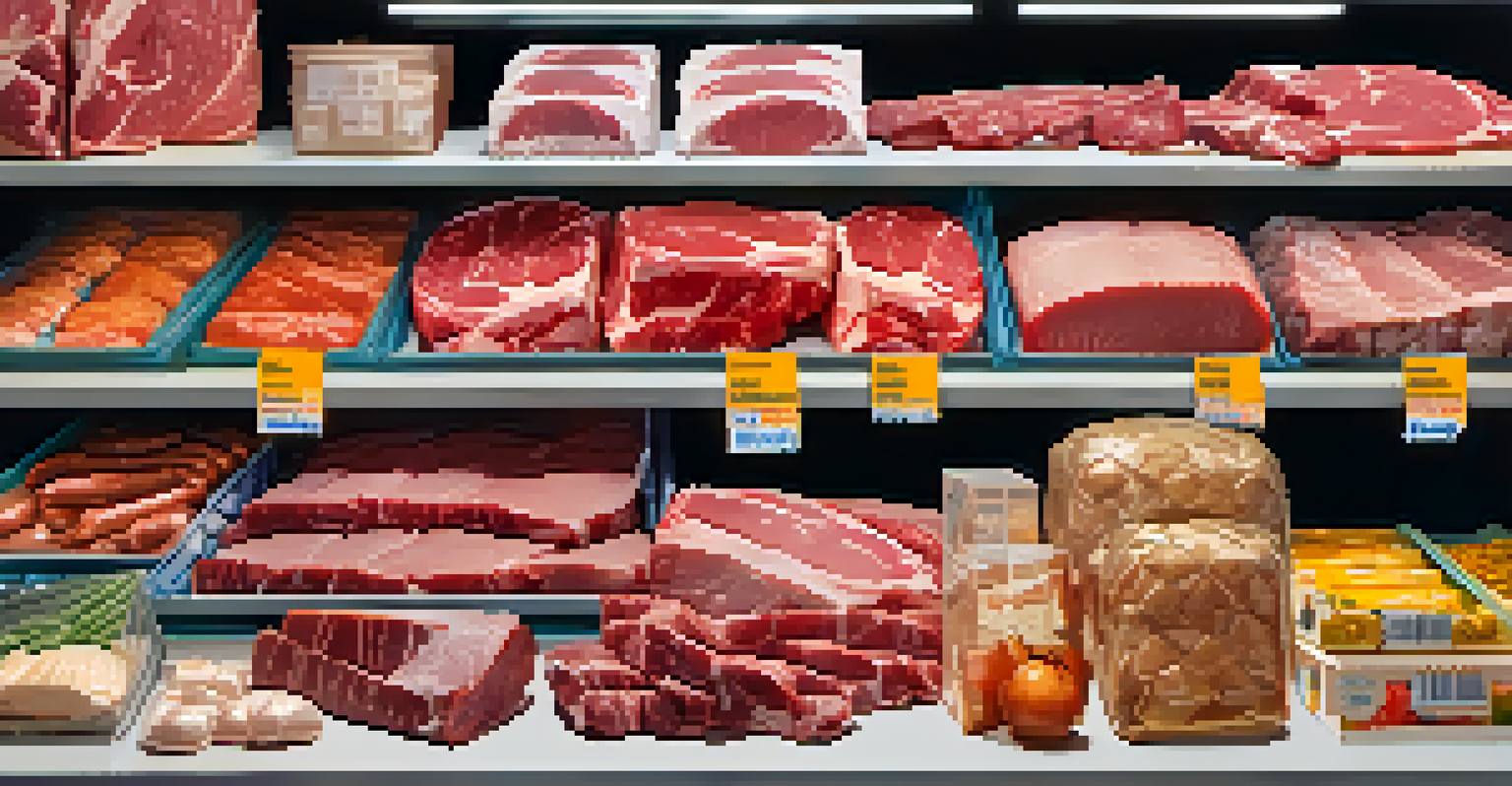Best Practices for Handling Raw Meat Safely

Understanding the Importance of Meat Safety
Handling raw meat safely is crucial to prevent foodborne illnesses, which can lead to serious health issues. Bacteria like Salmonella and E. coli can thrive on raw meat, making it imperative to follow safe practices. By being aware of the dangers and taking proper precautions, you can ensure that your meals are not only delicious but also safe for consumption.
Food safety is a shared responsibility. We all have a role in ensuring the food we eat is safe.
The kitchen is a common area where food safety issues arise, particularly when it comes to raw meat. Contaminated surfaces and utensils can easily spread harmful bacteria, posing risks to you and your family. Understanding the importance of handling meat safely can help you avoid these pitfalls and maintain a healthy cooking environment.
In addition to protecting your health, practicing safe meat handling also helps create a positive cooking experience. When you know how to keep your kitchen safe, you can focus more on enjoying the process and the delicious meals you create. So, let’s dive into the best practices that will keep your cooking safe and enjoyable.
Always Wash Your Hands Before and After Handling Meat
Hand hygiene is one of the simplest yet most effective ways to prevent contamination. Before you even touch raw meat, make sure to wash your hands with soap and warm water for at least 20 seconds. This step is vital in removing any bacteria that you may have picked up from other surfaces or foods.

After handling raw meat, it's equally important to wash your hands again. This prevents cross-contamination, where harmful bacteria from the meat can spread to other foods, utensils, or surfaces. Remember, just because you’ve washed your hands once doesn’t mean they’re clean after touching raw meat.
Prioritize Hand Hygiene for Safety
Washing your hands before and after handling raw meat is essential to prevent cross-contamination and ensure food safety.
Using hand sanitizer is a great addition, but it should never replace washing your hands with soap and water. Think of your hands as the primary tools in the kitchen; keeping them clean is crucial for ensuring food safety. So, don’t skip this important step!
Use Separate Cutting Boards for Meat and Other Foods
Using separate cutting boards for raw meat and other foods is a key practice in preventing cross-contamination. Imagine you’re slicing chicken on a board and then using the same board for vegetables without washing it first. This can easily transfer bacteria from the raw meat to your fresh produce—yikes!
You can't put a price on food safety. It’s about protecting lives.
To make things easier, consider color-coding your cutting boards. For instance, you could use a red board for raw meat and a green one for vegetables. This visual cue helps you remember which board to use for what, reducing the risk of accidental contamination.
It's also wise to ensure that your cutting boards are easy to clean and maintain. Wooden boards may absorb bacteria more than plastic ones, so choose materials that can be sanitized effectively. Investing in good cutting boards is a small price to pay for food safety.
Properly Store Raw Meat to Avoid Spoilage
Storing raw meat correctly is just as important as how you handle it. Make sure to place raw meat on the bottom shelf of your refrigerator. This prevents any juices from dripping onto other foods, which could lead to contamination.
Additionally, always check the expiration dates and ensure your meat is stored in an airtight container. This helps keep the meat fresh and reduces the risk of spoilage. It’s a good habit to inspect your meat before cooking to ensure it hasn’t gone bad.
Use Separate Tools for Meat
Utilizing different cutting boards and utensils for raw meat and other foods helps to avoid the spread of harmful bacteria.
If you’re buying meat in bulk, consider freezing portions you won’t use right away. Freezing can extend the shelf life significantly and helps maintain quality. Just remember to thaw it safely in the refrigerator or microwave, not on your countertop.
Thoroughly Cook Meat to Safe Temperatures
Cooking meat to the right temperature is essential for killing harmful bacteria. Using a food thermometer is the best way to ensure that your meat reaches a safe internal temperature. For example, chicken should be cooked to at least 165°F to be considered safe.
It’s easy to underestimate the importance of this step. Many people rely on visual cues, like color or texture, but these can be misleading. A thermometer takes the guesswork out of cooking and gives you peace of mind that your meal is safe to eat.
Remember, different types of meat have different safe cooking temperatures, so familiarize yourself with these guidelines. This small investment in a thermometer can make a big difference in the safety of your meals.
Clean and Sanitize Surfaces and Utensils After Use
After handling raw meat, it’s crucial to clean and sanitize all surfaces and utensils. Bacteria can linger on countertops, knives, and cutting boards, potentially contaminating other foods. A simple solution of warm soapy water is often enough to remove most bacteria.
For added safety, consider using a disinfectant spray or wipes specifically designed for kitchen use. These can kill any remaining bacteria, ensuring that your kitchen stays safe for food preparation. Always remember to let surfaces dry completely to maximize the disinfectant's effectiveness.
Cook Meat to Safe Temperatures
Using a food thermometer to ensure meat reaches safe internal temperatures is crucial for eliminating harmful bacteria.
Make it a habit to clean as you go while cooking. This not only keeps your kitchen tidy but also minimizes the risk of cross-contamination. A clean kitchen is a safe kitchen, so don’t overlook this important step!
Pay Attention to Expiration Dates and Signs of Spoilage
Being mindful of expiration dates is crucial in ensuring the safety of your meat. Always check the packaging before purchasing and consuming meat products. If you see a date that has passed, it’s best to avoid buying or using that meat altogether.
In addition to expiration dates, trust your senses. If meat has an off smell, unusual color, or slimy texture, it’s best to err on the side of caution and discard it. Your health is not worth the risk of consuming spoiled meat.

Developing a habit of regularly checking your fridge will help you stay on top of meat safety. It’s a small effort that can go a long way in preventing foodborne illnesses and keeping your meals safe.
Educate Others About Safe Meat Handling Practices
Sharing knowledge about safe meat handling can have a ripple effect in your community. Whether it’s family members, friends, or colleagues, teaching others about the importance of meat safety can help reduce the risk of foodborne illnesses. Everyone can benefit from understanding how to handle raw meat safely.
Consider organizing a small cooking class or workshop where you can demonstrate best practices. Not only is it a fun way to engage with others, but it also reinforces your own knowledge. Plus, it’s a great opportunity to bond over food!
Remember, knowledge is power. The more people understand safe meat handling, the less likely we are to see cases of foodborne illnesses. Let’s work together to create a culture of food safety in our homes and communities.